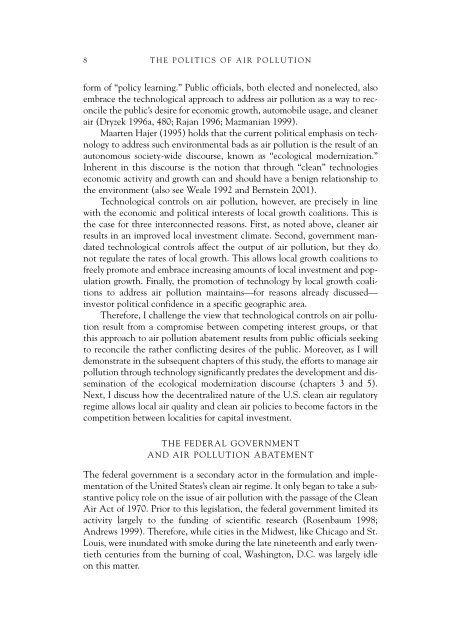GEORGE A. GONZALEZ - fieldi
GEORGE A. GONZALEZ - fieldi
GEORGE A. GONZALEZ - fieldi
Create successful ePaper yourself
Turn your PDF publications into a flip-book with our unique Google optimized e-Paper software.
8THE POLITICS OF AIR POLLUTIONform of “policy learning.” Public officials, both elected and nonelected, alsoembrace the technological approach to address air pollution as a way to reconcilethe public’s desire for economic growth, automobile usage, and cleanerair (Dryzek 1996a, 480; Rajan 1996; Mazmanian 1999).Maarten Hajer (1995) holds that the current political emphasis on technologyto address such environmental bads as air pollution is the result of anautonomous society-wide discourse, known as “ecological modernization.”Inherent in this discourse is the notion that through “clean” technologieseconomic activity and growth can and should have a benign relationship tothe environment (also see Weale 1992 and Bernstein 2001).Technological controls on air pollution, however, are precisely in linewith the economic and political interests of local growth coalitions. This isthe case for three interconnected reasons. First, as noted above, cleaner airresults in an improved local investment climate. Second, government mandatedtechnological controls affect the output of air pollution, but they donot regulate the rates of local growth. This allows local growth coalitions tofreely promote and embrace increasing amounts of local investment and populationgrowth. Finally, the promotion of technology by local growth coalitionsto address air pollution maintains—for reasons already discussed—investor political confidence in a specific geographic area.Therefore, I challenge the view that technological controls on air pollutionresult from a compromise between competing interest groups, or thatthis approach to air pollution abatement results from public officials seekingto reconcile the rather conflicting desires of the public. Moreover, as I willdemonstrate in the subsequent chapters of this study, the efforts to manage airpollution through technology significantly predates the development and disseminationof the ecological modernization discourse (chapters 3 and 5).Next, I discuss how the decentralized nature of the U.S. clean air regulatoryregime allows local air quality and clean air policies to become factors in thecompetition between localities for capital investment.THE FEDERAL GOVERNMENTAND AIR POLLUTION ABATEMENTThe federal government is a secondary actor in the formulation and implementationof the United States’s clean air regime. It only began to take a substantivepolicy role on the issue of air pollution with the passage of the CleanAir Act of 1970. Prior to this legislation, the federal government limited itsactivity largely to the funding of scientific research (Rosenbaum 1998;Andrews 1999). Therefore, while cities in the Midwest, like Chicago and St.Louis, were inundated with smoke during the late nineteenth and early twentiethcenturies from the burning of coal, Washington, D.C. was largely idleon this matter.









